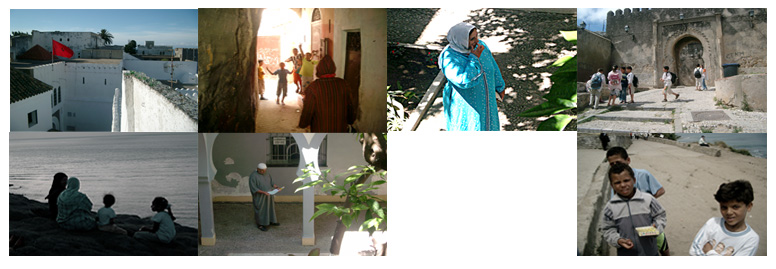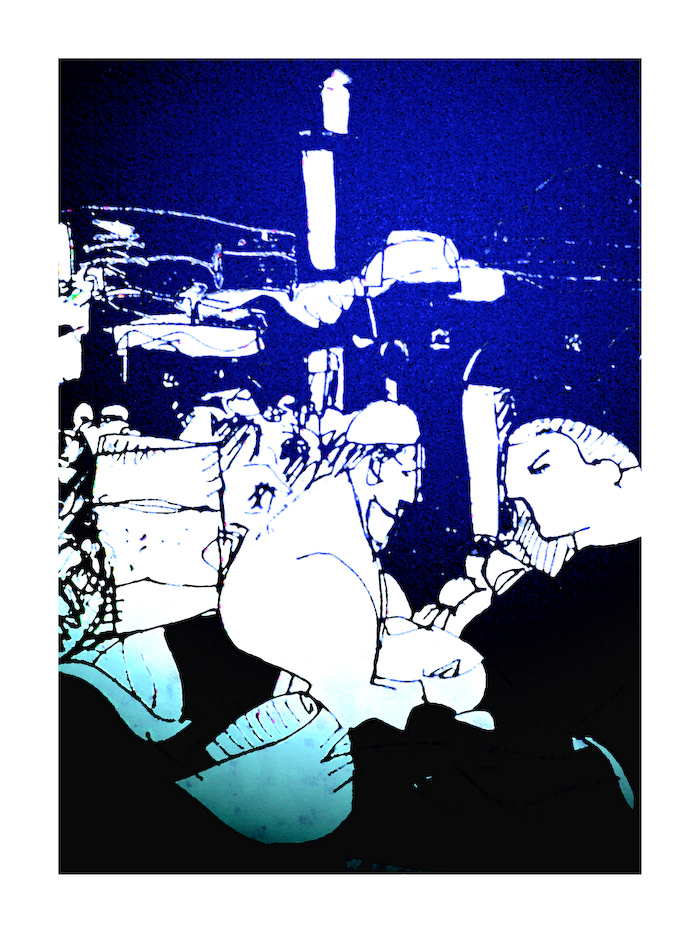
TANGIER (MOROCCO). CHILDREN OF THE STRAITS
Fragment of the homonym tale by Joan C. Roca Sans
The story of Driss
Tinjis was founded by the giant Antaeus, son of Poseidon, the god of the sea and of Gaia, the goddess of the earth. In Greek mythology, Morocco was described as a mythical Eden. Nowadays, its children have to leave.
The sharp crowing of a cockerel shook Driss from his thoughts and reminded him that he had been up for hours and that the sun had already painted the houses in the Medina ochre and blue. From time to time, a woman appeared on the roof to take down the clothes hanging out in the sun. Below, in the streets that climbed from the port to the Casbah, men drank tea and remembered the past. The tradesmen unfolded their wares awaiting the first tourists from the Costa del Sol who, spread all over the city, would end up buying souvenirs of their visit.
The conversation of the locals, always open to outsiders, mixed with the routine of the trading –animated by the hope of a good barter– with the conviction that the good times would come back to the city that knew so much about the comings and goings of the people who had passed through it.
Tangier, the white city, the city that never ceases to fascinate, stretched along the seashore like a white seagull settled on the back of Africa.
the east of the Casbah, other children who were the same age as Driss, swung on the poles of the bars that framed their view of the sea. Half the poles were missing, reminding them of the absence of those who had already left.
The ones that were still there were twisted like the fate of those who had failed during the crossing. On the other side of the city wall, Driss, sitting astride the piece of concrete that projected from the cliff, his gaze lost on the coast of Tarifa, submerged himself, once again, in his dreams about the water of the Straits. Further off, in the sea, an old dredger and a cargo ship anchored to the seabed and seemed to be waiting for the arrival of the Algeciras ferry.
Ahmed was arriving on the three o’clock Comarit line ferry to talk to Driss’ father about the job, while his mother would make sure she was looking elsewhere to ignore the fact that her son might have to undertake the dangerous route attached to the chassis of a lorry. From that moment on, many things were to change in both of their lives.
The Children of the Straits
It had already been a month since the Jihadists had blown up bombs in Casablanca and the day after the attack, the Generalitat’s signs had disappeared from the Toyota 4×4 assigned to the project. Now people were a little calmer and there were new additions. When night fell, Marc was sitting in the bar “Los Hijos del Estrecho” (The Children of the Straits), listening to music and chatting to Abdelhari, a hiking guide in the Atlas region, who spoke almost perfect Spanish and was very precise when expressing his opinions.
–In Greek mythology Tangiers was described as a mythical Eden –said Abdelhari– but now we are forced to emigrate. Here children don’t have material things but they have a rich life, the love of their parents and a beautiful land. But unfortunately they have no future other than precarious jobs and can earn very few Dirhams.
That’s why they want to cross over to the other side.
Marc knew that the Maghrebians loved their land deeply and felt very proud of it. But, travelling through the Rif villages, their arid hills and their dry ravines populated with red oleander, he couldn’t understand what that land had to deserve to be so deeply loved.
–We have crystalline seas and deep skies –continued Abdelhari–. The light that floods us is the beginning of all things, the first energy that was the origin of life. And when night falls, the smell of jasmine makes you feel drowsy and makes you think you are walking through an vague eternity.
When he heard the words of Abdelhari, Marc realised that, whether rich or poor, for a human being nothing is as sweet as his homeland.
© JC Roca Sans 2008
Tangier. Children of the Straits.
EXHIBITION AT THE
MUSEU DE LA MEDITERRÀNIA
In Can Quintana. Torroella de Montgrí (2 July – 29 August 2011).

VIDEO AND PHOTOGRAPHY
PRESS RELEASE
The Scent of Jasmine
This project has been designed and created by the visual artist Joan-Carles Roca Sans (Barcelona 1946) who, based on sketches au naturel, combines the media of photography, painting and video to show things from a different angle and break down the barriers that separate the new supports from the old ones, which are, after all, two sides of the same coin. To do this, he explores different media in a parallel way and shows how, going beyond hybridisation, each of them is infinitely versatile and that, directed by the software in the artist’s brain, they can be guided in one direction or another. He thus shows, once again, that art does not progress in a linear way, but by updating its origin.
A recurrent theme in Roca Sans’ production is the defence of values that have been disappearing in the name of progress, such as personal autonomy, solidarity and innocence, always found in his narrations. He proposes basing the understanding on mutual knowledge, seeking meeting points between different cultures and ideologies to show what human beings have in common and the need to respect everyone’s roots, principles and universal values.
The story of Driss, which takes place in Tangier, shows touching aspects of the inhabitants of this city which, in the past, was considered to be a mythical Eden and from which, today, its children are obliged to emigrate. One of the stars of the story, the Tangier group the children of the Straits, which keeps Sufic music alive without any kind of help or grant, is a beautiful example of the multiple capacities of art.
Roca Sans believes that, as Lévi-Strauss stated over half a century ago, travel has died and what is left is the experience and the narrative of the experience. This is why he constructs his stories on the go in order to represent, not reality, but what it hides.



































































